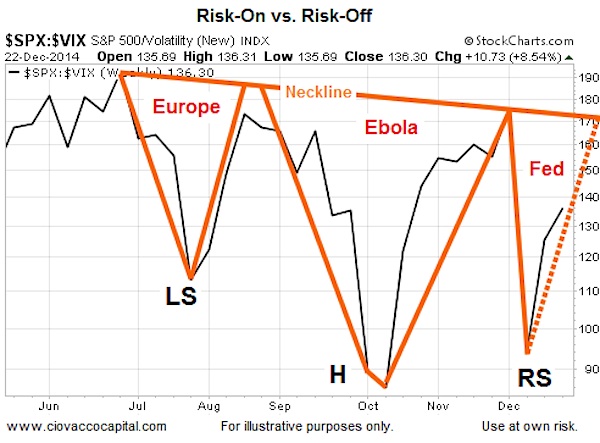While there are numerous reasons for the recent bout of volatility in asset prices, the market has primarily focused on concerns related to economic weakness in Europe, Ebola outbreak concerns, and the Federal Reserve. The chart below shows the performance of equities (via S&P 500) relative to the VIX Fear Index over the past several months. The orange lines highlight three recent spikes in fear, with the spike in the middle (Ebola) being larger than the other two (Europe & Fed).
S&P 500 (SPX):Volatility Index (VIX) Relative Performance Chart
Bullish Chart Patterns
The chart above contains some common characteristics found in a potentially bullish formation known as an inverse head and shoulders chart pattern. A break above the orange neckline will improve the odds that the current rally in equities will carry quite a bit further, breaking away from the VIX fear index. The chart above is not the only chart offering a potentially bullish look. In this week’s stock market video, we covered similar patterns in the small caps via iShares Russell 2000 (IWM), and the large caps via SPDR S&P 500 ETF (SPY) vs. bonds (IEF – ETF for 7-10 year treasury bond). We also looked at the broad NYSE Composite Index.
Investment Implications – The Weight Of The Evidence
Note that the market sold off prior to last week’s Federal Reserve meeting on the expectation that the removal of “considerable time” would signal a sooner than expected rate increase. Instead, the Fed delivered a more stock-friendly message and equities took off. As of Monday’s close, the market’s risk-reward profile allows us to hold an equity-heavy allocation. Given the recent wild swings between confidence and fear, we will continue to take things day-by-day, remaining flexible to both bullish and bearish outcomes. Thanks for reading.
Read more from Ciovacco Capital here.
Follow CCM on Twitter: @CiovaccoCapital.
Author holds positions in securities mentioned at the time of publication. Any opinions expressed herein are solely those of the author, and do not in any way represent the views or opinions of any other person or entity.









